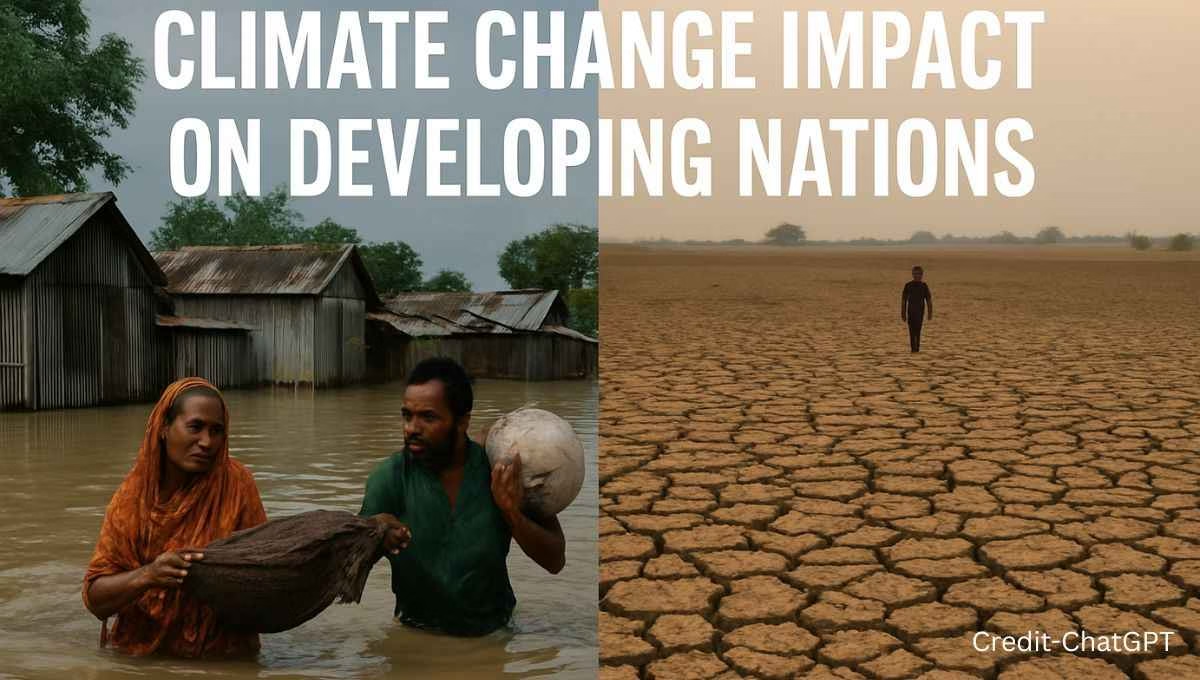Why Climate Change Is a Global Crisis for Developing Countries
The climate change impact on developing countries is one of the most urgent challenges the world faces today. Rising global temperatures, extreme weather events, and sea level rise threaten not just the environment but millions of vulnerable lives. Developing nations, already struggling with economic and social challenges, bear the brunt of these environmental changes. The lack of adequate infrastructure, limited financial resources, and weak governance structures make it extremely difficult for these countries to adapt or recover from climate-related disasters.
1. Geographical Vulnerability of Developing Countries
The climate change impact on developing countries is intensified by their geographical location. Many small Island Developing States (SIDS), such as the Maldives and Tuvalu, are at high risk of being submerged due to rising sea levels. Coastal and river delta regions in Bangladesh and Sub-Saharan Africa are particularly susceptible to floods, cyclones, and desertification.
For instance, Bangladesh faces regular cyclones and coastal erosion, while the Sahel region in Africa sees desertification spreading rapidly. These vulnerabilities worsen the climate change impact on developing countries, making it harder to sustain agriculture, manage freshwater supply, and maintain economic stability.
2. Agriculture and Food Security at Risk
The climate change impact on developing countries is most visible in agriculture, which is the backbone of many of their economies. Erratic rainfall, extended droughts, and flooding result in frequent crop failures and reduced agricultural yields. This directly impacts food security, especially for smallholder farmers who rely on subsistence farming.
In Sub-Saharan Africa, staple crops like maize and sorghum are highly sensitive to these changing conditions. In South Asia, rising salinity due to sea level rise renders previously arable land unsuitable for rice cultivation. Most farmers lack access to climate-resilient technologies or irrigation systems, deepening poverty and hunger.
3.Water Scarcity Worsened by Climate Change
A major consequence of climate change impact on developing countries is the increasing water scarcity. Glacial melts from the Himalayas affect major river systems such as the Ganges and Indus, threatening freshwater supply for millions downstream.
Countries such as Ethiopia, Kenya, and Pakistan experience prolonged droughts, while flash floods pollute water sources during the rainy season. The lack of modern water management infrastructure compounds the problem, leaving millions without reliable access to clean water.
4. Growing Health Risks Due to Climate Change
The climate change impact on developing countries is further evident in the alarming rise of health issues. Increased temperatures and changing ecosystems allow disease vectors like mosquitoes to thrive, resulting in more cases of malaria, dengue, and Zika virus.
Poor urban planning and inadequate healthcare systems leave slum populations vulnerable to heatwaves and waterborne diseases such as cholera and typhoid. Weak immune systems due to malnutrition and food insecurity exacerbate the health burden.
5. Economic Strain and Poverty Cycle
The climate change impact on developing countries takes a massive toll on their economies. Agriculture, infrastructure, and small businesses suffer significant losses during extreme weather events like floods and cyclones. Many small and medium enterprises (SMEs), critical to local employment, are left unable to recover from climate shocks.
Rebuilding efforts drain government budgets, hindering investment in critical services such as education and healthcare. The World Bank warns that by 2050, GDP losses in some developing nations could reach up to 5% annually due to climate change.
6. Forced Migration and Climate Refugees
One of the most visible signs of the climate change impact on developing countries is the rise in forced migration. In Bangladesh, millions face displacement due to coastal erosion and flooding. In Sub-Saharan Africa, desertification displaces pastoral communities, often triggering conflict over limited resources.
Despite the growing number of climate refugees, global legal protections remain insufficient, leaving many displaced individuals in precarious situations without clear legal status or access to basic services.
The climate change impact on developing countries highlights the need for global responsibility. Developed nations, responsible for the majority of greenhouse gas emissions, must assist developing nations through financial aid, technology transfer, and capacity-building programs.
International agreements such as the Paris Agreement set the foundation for cooperation, but stronger enforcement and ambitious national climate action are needed to support the most vulnerable populations.
A Call for Urgent Action
The climate change impact on developing countries is already disrupting lives, livelihoods, and economies. From worsening food insecurity and water scarcity to health crises and forced displacement, the challenge is complex and urgent. Global solidarity is critical to provide financial support, share technological innovations, and promote sustainable development strategies.
To effectively address the climate crisis, the international community must prioritize equitable solutions that empower developing nations to adapt, build resilience, and achieve sustainable growth.
Hi, this is Admin from Indnexa. We publish content here that is authentic and has value for our readers. We do not mislead our readers by publishing fake news . We cover news related to Entertainment, Sports, Investments, Health, and so on. Providing the best news for our readers is our main motto. With a keen eye for detail and a drive to inform and inspire, we try to transform complex ideas into accessible content for curious minds.
